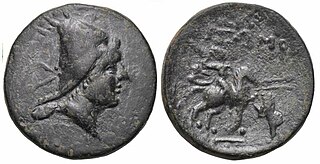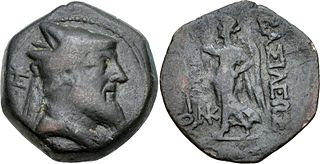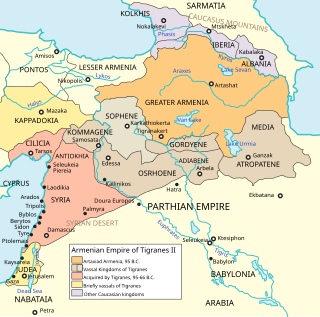This article concerns the period 229 BC – 220 BC.
Year 226 BC was a year of the pre-Julian Roman calendar. At the time it was known as the Year of the Consulship of Messalla and Fullo. The denomination 226 BC for this year has been used since the early medieval period, when the Anno Domini calendar era became the prevalent method in Europe for naming years.
Year 228 BC was a year of the pre-Julian Roman calendar. At the time it was known as the Year of the Consulship of Ruga and Verrucosus. The denomination 228 BC for this year has been used since the early medieval period, when the Anno Domini calendar era became the prevalent method in Europe for naming years.
Antiochus is a Greek male personal name, likely meaning "resolute in contention", or "unwavering". It is derived from the two words αντί ("against") and ὄχη ("support"). It was a dynastic name for rulers of the Seleucid Empire, and the kingdom of Commagene. In Jewish historical memory, connected with the Maccabean Revolt and the holiday of Hanukkah, "Antiochus" refers specifically to Antiochus IV Epiphanes.

Seleucus II Callinicus Pogon, was a ruler of the Hellenistic Seleucid Empire, who reigned from 246 BC to 225 BC. Faced with multiple enemies on various fronts, and not always successful militarily, his reign was a time of great turmoil and fragmentation for the Seleucid Empire, before its eventual restoration under his second son and eventual successor, Antiochus III.
Laodice I was a Greek noblewoman of Anatolia who was a close relative of the early Seleucid dynasty and was the first wife of the Seleucid Greek King Antiochus II Theos.

The Kingdom of Pergamon, Pergamene Kingdom, or Attalid kingdom was a Greek state during the Hellenistic period that ruled much of the Western part of Asia Minor from its capital city of Pergamon. It was ruled by the Attalid dynasty.
Ziaelas, third king of Bithynia, was a son of Nicomedes I and Ditizele.
Mithridates II, third king of Pontus and son of Ariobarzanes, whom he succeeded on the throne.

Antiochus, called Hierax for his grasping and ambitious character, was the younger son of Antiochus II and Laodice I and separatist leader in the Hellenistic Seleucid kingdom, who ruled as king of Syria during his brother's reign.

Ariaramnes, was the Ariarathid king of Cappadocia from 280 BC to 230 BC. He was the son and successor of Ariarathes II.

Sophene was a province of the ancient kingdom of Armenia, located in the south-west of the kingdom, and of the Roman Empire. The region lies in what is now southeastern Turkey.
The Orontid dynasty, also known as the Eruandids or Eruandunis, ruled the Satrapy of Armenia until 330 BC and the Kingdom of Armenia from 321 BC to 200 BC. The Orontids ruled first as client kings or satraps of the Achaemenid Empire and after the collapse of the Achaemenid Empire established an independent kingdom. Later, a branch of the Orontids ruled as kings of Sophene and Commagene. They are the first of the three royal dynasties that successively ruled the ancient Kingdom of Armenia.

Arsames I seems to have taken control of Commagene, Sophene and Armenia in the year 260 BC after the death of his grandfather Orontes III, king of Armenia, and his father Sames, king of Commagene.

Xerxes was king of Sophene and Commagene from 228 BC to 212 BC. He was the son and successor of Arsames I.
Ptolemaeus was initially the satrap of Commagene, later becoming its first king in 163 BC. He belonged to the Orontid dynasty, founded by Orontes I. Ptolemaeus' father was King Orontes IV of Armenia, son of Arsames I.

The Kingdom of Sophene, was a Hellenistic-era political entity situated between ancient Armenia and Syria. Ruled by the Orontid dynasty, the kingdom was culturally mixed with Greek, Armenian, Iranian, Syrian, Anatolian and Roman influences. Founded around the 3rd century BCE, the kingdom maintained independence until c. 95 BCE when the Artaxiad king Tigranes the Great conquered the territories as part of his empire. Sophene laid near medieval Kharput, which is present day Elazığ.
Laodice was a Greek Princess of the Seleucid Empire. She was one of the daughters and youngest child born to the Seleucid Monarchs Antiochus II Theos and Laodice I. Among her siblings were her brothers Seleucus II Callinicus and Antiochus Hierax. Laodice was born and raised in the Seleucid Empire.
Alexander was a Greek nobleman of Anatolia and served as a Seleucid official.
The Battle of Ancyra was fought in ca. 239 BC between the Seleucid King Seleucus II Callinicus and his brother Prince Antiochus Hierax. Civil war had raged in the Seleucid Empire since 244 BC, when Queen Laodice I had supported her son Antiochus in a rebellion against Seleucus. Antiochus fought to establish his own kingdom in Anatolia. He was able to take advantage of his brother's distraction and defeat at the hands of Ptolemy III in the Third Syrian War. By 239 BC Seleucus had made peace with Ptolemy and having rebuilt his army, invaded Anatolia.








